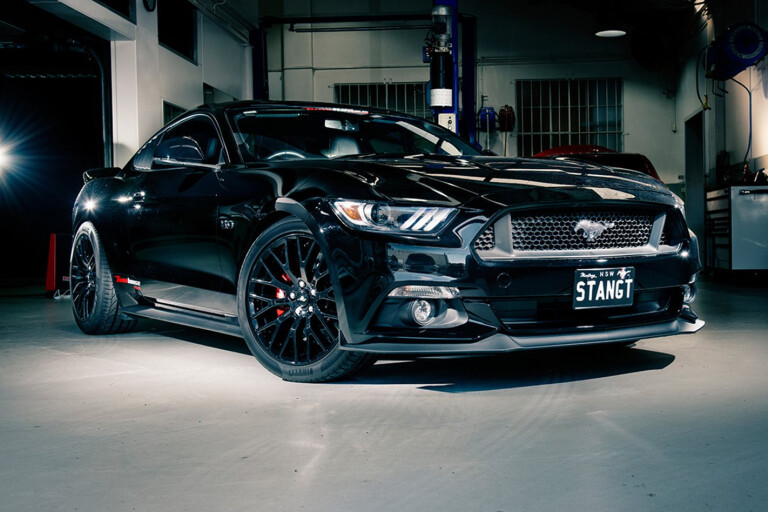
IT COULD have been a 10-car Mustang Shootout if Tunehouse from Sydney had sent its glossy black beast of a car to chilly Winton.
Alas, we must admire it from afar. And with Sydney tuners direly unrepresented at our Victorian dust-up, Tunehouse's was too good an example not to include on the back of our world-first Mustang shootout.
If there was the equivalent for the People for the Ethical Treatment of Animals (PETA) they would certainly be called in to rescue this Tunehouse-tuned Ford Mustang GT.
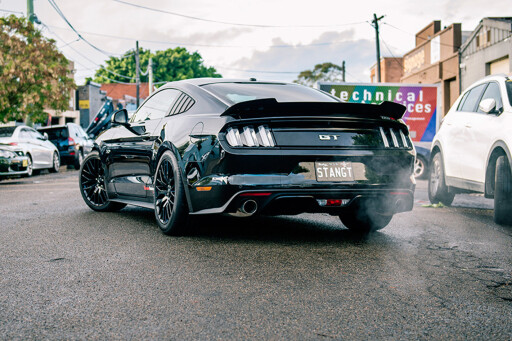 Jamming 700 horses into a stable the size of this ponycar’s snout doesn’t only sound welfare sirens, but cramming them into a rear-driven two-door with unchanged back tyres seems as smart as allowing any champers-swilling spectator to replace a jockey at the races. No doubt the ride will be furious, but so will the ambos rushing in to clean up the mess.
Jamming 700 horses into a stable the size of this ponycar’s snout doesn’t only sound welfare sirens, but cramming them into a rear-driven two-door with unchanged back tyres seems as smart as allowing any champers-swilling spectator to replace a jockey at the races. No doubt the ride will be furious, but so will the ambos rushing in to clean up the mess.
Of course, regular MOTOR readers will know that 15-year-old Tunehouse is about harnessing power as much as exploiting it. Efforts with the Mazda MX-5 and Toyota 86 at our Hot Tuner events have impressed, and the boys in the last remaining industrial part of gentrified Marrickville, in Sydney’s inner-west, promise this is more than a one-trick pony.
The Tunehouse headquarters is surrounded by red-bricked roller-door tuning-fodder, but it soon becomes clear that just as hipsters thrive on finding their creative flow in repurposed industrial warehouses, there’s engineering talent lurking in the shadows here to be especially cherished in this final year of Australian vehicle manufacturing.
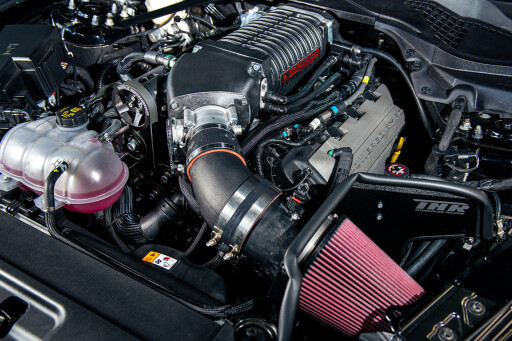 After all, some sniggered at the boys from Clayton once. Some still do, ignorantly and incorrectly. “We’ve identified where the Mustang platform lacks and without re-inventing the Ford engineers’ intentions, we believe we have bettered it,” explains Tunehouse managing director Jim Ghelis.
After all, some sniggered at the boys from Clayton once. Some still do, ignorantly and incorrectly. “We’ve identified where the Mustang platform lacks and without re-inventing the Ford engineers’ intentions, we believe we have bettered it,” explains Tunehouse managing director Jim Ghelis.
“From the supercharger, to the brakes and custom-spec suspension, it’s all about balancing power, handling and driveability to us.” So what do we have here? Simply, a $57,490 (plus on-road costs) Mustang GT manual with a 306kW/530Nm 5.0-litre V8, plus a $30,000 performance package added.
To our mind, this needs to be a Trans-Pacific BMW M240i-to-M2 challenger. For that price Tunehouse includes installation of a styling kit, including lip and rear spoilers, side skirts and rear quarter-window gills that rear passengers probably won’t love. But those passing by certainly did.
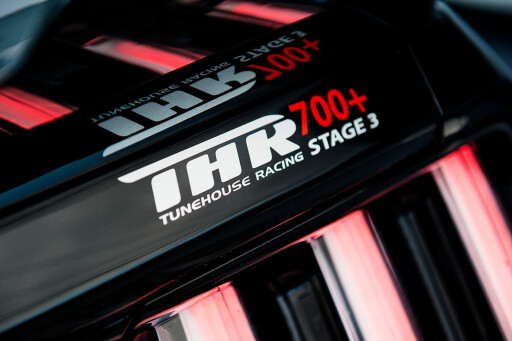 The ‘Tunehouse Racing 700+ Stage 3’ rear decklid badge we could live without, only partially because Highway Patrol read it as ‘Book Me Now Please'. After all, the headline act here is a 2.9-litre Whipple supercharger, which takes outputs to around 630kW and 980Nm at the crank, or 475kW and 740Nm at the wheels.
The ‘Tunehouse Racing 700+ Stage 3’ rear decklid badge we could live without, only partially because Highway Patrol read it as ‘Book Me Now Please'. After all, the headline act here is a 2.9-litre Whipple supercharger, which takes outputs to around 630kW and 980Nm at the crank, or 475kW and 740Nm at the wheels.
More than 600Nm is available from 2000rpm. But Ghelis calls this a “mild tune only”. Holding the reins on all that horsepower are two-piece slotted brake rotors in the same 380mm size as stock and braided lines with uprated pads.
Made in Germany, the custom H&R coilover suspension includes Tunehouse-developed swaybar (with adjustable end links, swaybars and swaybar locks) and camber adjustment kits, transmission shift bushings, while a Streetfighter adjustable sports exhaust rounds out the additional 50 per cent spent over a Mustang GT’s retail price.
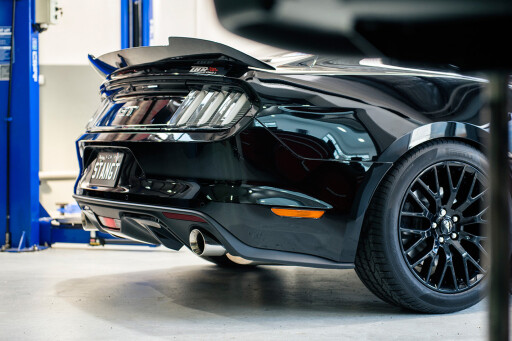 Ghelis says the changes are designed to improve ride comfort while banishing the floatiness of the standard car. At which point – having steered a stock ’Stang alongside a Commodore SS-V Redline and been disappointed and delighted by each model’s respective body control – this tester is nodding vigorously.
Ghelis says the changes are designed to improve ride comfort while banishing the floatiness of the standard car. At which point – having steered a stock ’Stang alongside a Commodore SS-V Redline and been disappointed and delighted by each model’s respective body control – this tester is nodding vigorously.
So, then, will this be a ropey stallion: yay or neigh? Snaking out of Sydney’s inner-west on a soaked Sunday morning, it’s all early upshifts and avoiding trouble from the boys in blue – or the boys in scarves not wanting their smashed avocado covered in PULP. But for something not exactly pure-bred, this ’Stang feels tamed.
The clutch doesn’t feel as weighty as a gym leg press, and the same terrific short manual throw and burbly V8 growl under 3000rpm remains. Expansion joints and potholes are dispatched with firm thuds rather than the sort of crashing and jarring often found with aftermarket chassis tunes.
 The exhaust bubbles, seguing into a bark, but it’s never bratty. Powering onto the freeway comes a reminder that in the wet the throttle needs to be treated with the sort of gentility reserved for patting manes, not whipping sides.
The exhaust bubbles, seguing into a bark, but it’s never bratty. Powering onto the freeway comes a reminder that in the wet the throttle needs to be treated with the sort of gentility reserved for patting manes, not whipping sides.
Even with care there’s wheelspin and slight sideways action in first, second, third, and – just as the GT endows the driver with confidence that maximum throttle can be used – fourth gears. With so much grunt, the 275mm-wide 19-inch Pirelli rears have lost almost all concept of traction, in the wet at least.
Trying to discern the shift between 300kW to near-500kW in a rear-driven car – with finite grip – is actually more like trying to pick the changes between negative-20 degrees Celsius, and negative-10 degrees, in a Detroit winter. By this stage we’re talking extra shades of fricking fast and freaking cold respectively.
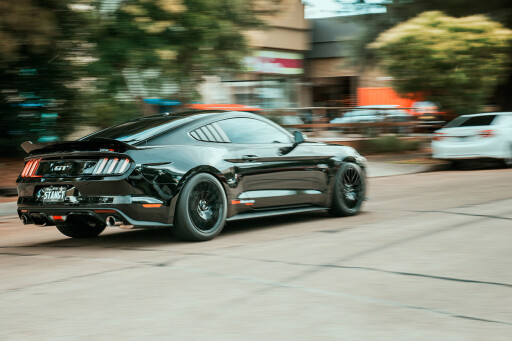 Thankfully, the roads dry as they turn country and winding. Time for a good gallop. The deep and warbly soundtrack at low revs starts to change beyond 3000rpm when the blown 5.0-litre really begins to punch. The rush beyond 4000rpm is sterling, at which point it’s all sweet supercharged shrill and shriek towards the 7000rpm cut-out.
Thankfully, the roads dry as they turn country and winding. Time for a good gallop. The deep and warbly soundtrack at low revs starts to change beyond 3000rpm when the blown 5.0-litre really begins to punch. The rush beyond 4000rpm is sterling, at which point it’s all sweet supercharged shrill and shriek towards the 7000rpm cut-out.
It feels like there’s a bit of ‘torque staging’ going on in the lower gears to manage wheelspin, a technique used by Ferrari with the 760Nm rear-driven 488 GTB and definitely not used by BMW with its edgy 550Nm M3/M4. Later Ghelis confirms that trick electronics are indeed at play as part of what he calls major engine management advances in recent years.
So much for the tuning stereotype of dialling up the boost and letting ’er rip. Third-gear acceleration from 100km/h is stupendous. The way the speedo needle snaps towards 150km/h is the stuff of hypercars, not mere supercars. The mid-range response is gorgeous, but the blown eight is also willing to sweep to the top-end as well.
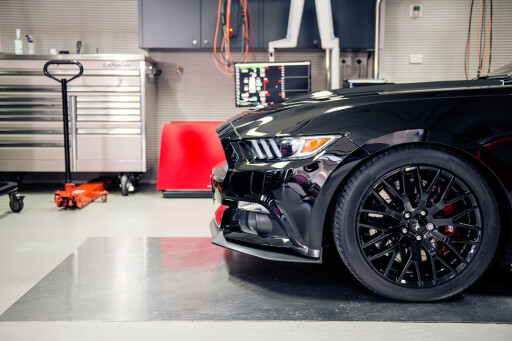 The clear highlight, however, is immaculate throttle response at any point on the tachometer that endows the GT with an eagerness – but not aggression – to pull at its leads everywhere. It’s a trait missing from the more mundane naturally-aspirated engine.
The clear highlight, however, is immaculate throttle response at any point on the tachometer that endows the GT with an eagerness – but not aggression – to pull at its leads everywhere. It’s a trait missing from the more mundane naturally-aspirated engine.
Far from feeling like a wayward lass on country roads like the stock Ford can, this is a tauter, trimmer, fitter Pony that more confidently gels with its steering and stability control (ESC). No longer does the front-end wallow and slap on country roads above seven-tenths pace, which causes the ESC on the standard car to respond more to vertical pitching than sideways movement.
You read that right, on a rear-driven V8. C’mon ’Murica. With the Tunehouse tune there is simply firm discipline everywhere. The lenient ESC still works with the power upgrade, but keeping the ’Stang in a controlled powerslide is all down to that throttle response, which drills the driver’s right foot into the back axle to adopt the role of a minutely measured disperser of latitude.
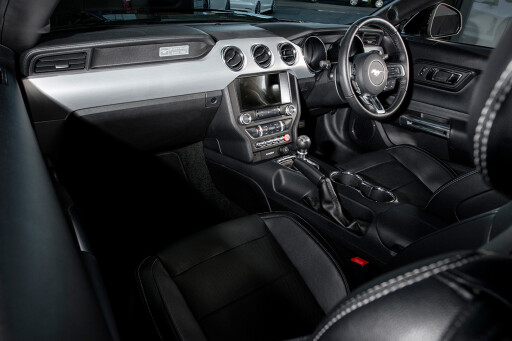 By contrast the driver’s hands can feel like they’re massaging a fast-spinning pottery wheel, where clay needs to be delicately handled and is only a finger’s width away from ruining the walls. It’s a fine line between sensitivity and hard work with the steering of this Mustang.
By contrast the driver’s hands can feel like they’re massaging a fast-spinning pottery wheel, where clay needs to be delicately handled and is only a finger’s width away from ruining the walls. It’s a fine line between sensitivity and hard work with the steering of this Mustang.
Although its initial sharpness is nice, which makes the Ford feel faux-agile, as lock is wound on it becomes completely mute and the front-end feels aloof. Tunehouse isn’t a big fan of the Mustang’s standard electric tiller-tune and nor are we. In fact, the remaining problems of this car are Ford – not Tunehouse – specific.
Whether teamed with 306kW, or 630kW, the short-ish wheelbase of this two-door can induce some terse and snappy oversteer behaviour unlike what Aussies might be used to in a blown HSV with its rear axle swinging into a different postcode to the front. And the cramped, scrappy cabin feels $30K beneath $55K – not the same amount over it.
 Blue Oval badge aside, though, the Tunehouse Mustang GT could have emerged from HSV. The simpleton ‘tuner special’ stereotype doesn’t apply here. This feels OEM-plus, factory enhanced, and so much better than the standard coupe.
Blue Oval badge aside, though, the Tunehouse Mustang GT could have emerged from HSV. The simpleton ‘tuner special’ stereotype doesn’t apply here. This feels OEM-plus, factory enhanced, and so much better than the standard coupe.
If import-tweaking is our post-manufacturing future, then we’ll raise a burly muggacino to the gentrification of the tuning brigade that has seen sophistication replace slap-dash. For now, our home-grown heroes – or disappearing dinosaurs if you work in a refurbished industrial creative space – remain the better sports cars, if not the superior show ponies.
0-100km/h? 0-400m?
Tunehouse reckons its Mustang will run somewhere between 3.6 and 3.9sec to 100km/h and an 11.2 to 11.5sec quarter mile, in both cases “if traction permits”. Through the seat of the pants it feels ‘low 3s’ quick in the mid-range, but ‘high 4s’ brisk from a standing start.
So much patience is required off the line in order to allow the 275mm rear Pirellis to hook up, with valuable time lost. As MOTOR has found in the past, throwing more grunt at a duo of back wheels isn’t the key to achieving faster performance times – surprise, surprise.
We would look to a larger set of rears, maybe 315mm Michelin Pilot Super Sport rubber, just to complete the package. Then again, how long is a piece of string? For many, that’s the modification life.
Tunehouse Ford Mustang GT Specs:
Body: 2-door, 4-seat coupe
Drive: rear-wheel
Engine: 4951cc V8, DOHC, 32v, supercharger
Power: 630kW
Torque: 980Nm
Transmission: 6-speed manual
Weight: 1739kg (standard car)
Suspension (f): struts; coil springs; anti roll-bar;
Suspension (R): multi-links; anti roll-bar;
Wheels: 19 x 9.0-inch (f); 19 x 9.5-inch (r)
Tyre sizes: 255/40 R19 (f); 275/40 R19 (r)
Tyres: Pirelli P Zero
L/W/H: 4783/1915/1382mm
Wheelbase: 2720mm
0-100km/h: 3.9sec (claimed)
Price: $87,490 (standard car)

COMMENTS